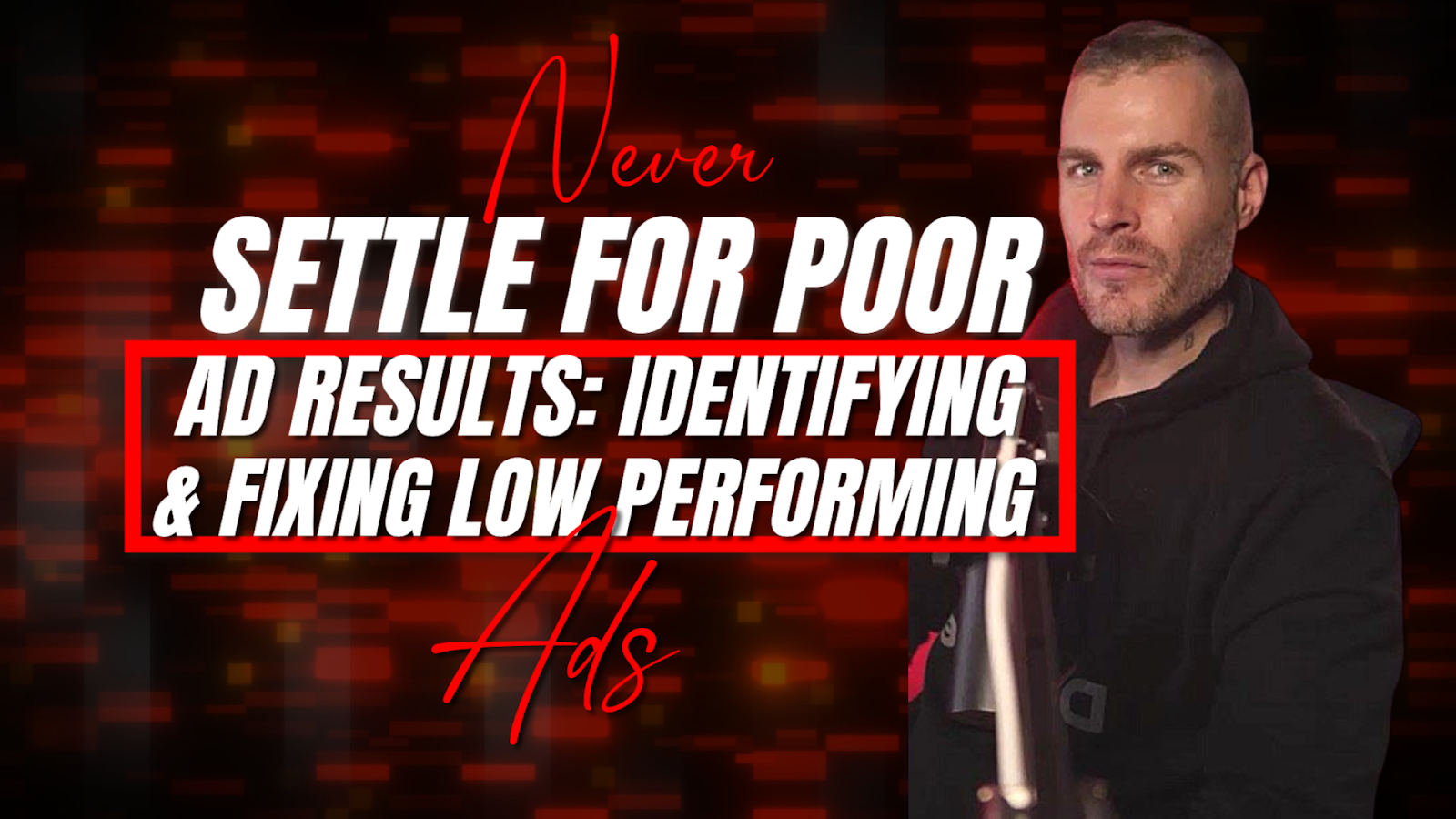
Never Settle For Poor Results: Identifying and Fixing Low-Performing Ads
Advertising can be a powerful tool for driving growth and revenue for your business. However, not all ads are created equal, and it’s important to regularly monitor and optimize your advertising campaign to ensure that your ads are performing at their best. Low-performing ads can be costly and ineffective, but by identifying and fixing them, you can improve the performance of your campaign and drive better results. In this topic, we will explore strategies for identifying low-performing ads and discuss effective techniques for fixing them to achieve optimal campaign performance. By implementing these strategies, you can take your advertising efforts to the next level and achieve greater success in your marketing efforts.
A strategic approach to Facebook Ads management can help you identify and revive Low Performing Ads. This guide is designed to help digital marketers get a hold of their Low Performing Ads and fix the problem to get back on track.
Common Reasons for Low Performing Ads:

To identify low-performing ads and adjust or relocate your ad spend, you must first know what goes wrong with the ads in the first place. Some common factors leading to Low Performing Ads include:
- Wrong choice of audience
Choosing the wrong target audience is the biggest problem. It is important to align the ad type, budget, and objective with the audience type, demographics, and location. - Wrong choice of Campaign objective
If you fail to align the campaign’s objective with the audience position in the sales funnel, the outcome will be compromised. - Wrong choice of Visuals
Unappealing visuals and copy are other reasons to compromise the quality and performance of ads. - Wrong choice of landing pages
A landing page that does not sync with the ad copy can also affect the performance of the ads.
If any one or more factors out of the ones mentioned above go wrong, the problem of Low Performing Ads arises.
How to Identify Low Performing Ads?
- Use A/B testing: A/B testing involves running two ads simultaneously and comparing their performance to determine which one is more effective. You can test different ad elements such as headlines, images, ad copy, and calls to action. If one ad is consistently underperforming compared to the other, it may be low performing.
- Analyze your key performance indicators (KPIs): The first step in identifying low-performing ads is to look at your KPIs. This could include metrics like click-through rate (CTR), conversion rate, cost per click (CPC), cost per acquisition (CPA), and return on ad spend (ROAS). Ads that have low KPIs compared to other ads in your campaign may be low performing.
- Monitor ad frequency: Ad frequency refers to how many times an ad has been shown to a particular user. If an ad has a high frequency and a low engagement rate, it may be time to replace or refresh the ad.
- Use A/B testing: A/B testing involves running two ads simultaneously and comparing their performance to determine which one is more effective. You can test different ad elements such as headlines, images, ad copy, and calls to action. If one ad is consistently underperforming compared to the other, it may be low performing.
- Check ad placement: The placement of an ad can impact its performance. Ads that are placed in less visible locations may not perform as well as those that are prominently displayed.
- Look at historical performance: Historical performance can provide insight into which ads have consistently performed well and which ones have not. If an ad has consistently underperformed, it may be time to retire it.
How to fix low performing Ads?

As soon as you have identified the poorly performing ads, you must start reviving them as when left unattended, they can affect your overall marketing performance.
Here are a few ways to work on your low performing ads:
1. Audit your Video thumbnail for too much text
If you are facing trouble with your Facebook Video ads, it is time to audit the thumbnail as it could be the primary reason behind the failure.
Having too much text on the thumbnail image is a leading reason why Facebook video ads fail. Just like ad images, too much text is distracting and often penalized by fewer placement opportunities. A little adjustment with the ad copy can win you great results and you can soon see your low performing ads climbing the charts.
2. Rely on Google Analytics as much as you can
You can use a wide range of tools to evaluate the performance of your ads and simultaneously pinpoint Low Performing Ads. However, the accuracy of results from Google Analytics matches none other. The free tool offers you great insights into ad performance including click-throughs, conversions, any special point of user drop, and more.
If you are experiencing a high bounce rate, there are several possible reasons for it including an Irrelevant landing page, wrong target audience, extremely high price range, and ad copy not convincing enough.
Google Analytics lets you identify the point where the users are dropping off.
3. Assess the Ad copy
Your ad copy is very important as it is what the audience reads and evaluates. Having weak words on the ad copy or poor marketing efforts can spoil the entire ad campaign and result in a high number of Low Performing Ads.
Some aspects to check when assessing the Ad copy include:
- Clarity of the objective: the ad copy should be convincing enough to encourage the target to take the action.
- Clarity of the outcome: The ad copy must define the benefits of the action clearly.
- Clarity of the message: The ad copy must have the message written in bold and clear.
- Clarity of the target audience: The ad copy must be written with the target audience in mind.
4. Evaluate your target audience
Sometimes, the choice of the target audience is the primary reason why an ad would start performing lower than expected. Ensuring that you are showing your ad to the right audience is very important to ensure successful ad performance.
You should go for a broader audience base and not make an exact audience. Here are a few parameters that influence the campaign’s target audience:
- The interest of the audience
YOu must continuously audit and optimize your ad copy but beginning with the right target audience has its advantages. Make sure you learn the interest of the target audience before making an ad copy. - Location of the audience
You need to ensure that you choose the audience based on the location. You can either target locally or go on a national scale to target your audience. - Budget
If you can keep the budget high, you will have the advantage of auto bidding. This also means that the traffic you receive will be higher and vice versa with a smaller budget. However, this again depends on the location of the target audience.
5. Make an enticing Ad copy
Your content copy is of great essence and you must ensure that it is attractive and engaging enough. The span of attention for the user is very short as they only look at your ad copy while scrolling their feed. Using the right words and visuals is very important as no one has time to read a full page or engage in a dull copy.
You need to pay attention to a few aspects of ad copy-making at the beginning. You can also use these factors to revive your Low Performing Ads.
- Is the ad copy noticeable?
At least one focal point is important to make an engaging and attractive Ad copy. - Is the brand link visible?
Make sure that the audience can easily connect your brand with the ad copy. - Is the incentive clear?
The benefit of the ad should be highlighted in the Ad copy. - Is the ad copy educating?
The audience seeks information and an ideal ad copy must be able to provide it. - Can you emotionally connect through the ad copy?
If you can connect with the audience emotionally through the ad copy, consider it successful. - Is the CTA clear?
An ad copy with an unclear Call To Action is worth nothing. Make sure you compel the audience to take action.
6. Tweak/ optimize your landing page
An ad campaign is considered successful when it can attract the right audience pool, lower the cost of acquisition, and leads customers to the apt landing page. Here the efficacy of your landing page matters a lot as it is the platform that finally leads to conversions. Make sure you work on your landing page to avoid the problem of Low Performing Ads in the first place.
Some effective ways to maintain an optimized landing page include:
- Ensure sync between the information on the ad copy and the landing page.
- Keep the lead form short and simple to fill. It must have a maximum of 4 fields and no more.
- Keep a tab on the pricing and highlight your Unique Selling Points.
- Make the website easy to navigate and simultaneously help out the customer.
- Keep the checkout process simple and swift.
- Make sure the users are directed to the landing page only and not to any third-party pages.
- Speed up the website performance and loading speed.
- Use a conversion tracking tool to keep track of the work.
7. Read the comments and act on them
Always be attentive to your comments section and make sure you engage with your audience from time to time. You might get the same engagement level from your ads but with declined conversions. The primary issue is negative comments on your ad copies which prevent potential clients from trusting you, make sure you take care of the negative comments and maintain conversions.
To conclude:
Creating and then optimizing your ad campaign is very important to timely identify and rectify Low Performing Ads. The above-mentioned strategies work efficiently in handling low-performance issues with ads. Always remember that the quicker you react the more losses you prevent. Track your ads closely and as soon as you suspect a dip in performance, use these strategies to revive.
